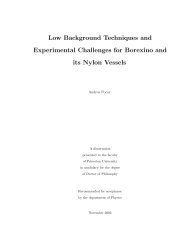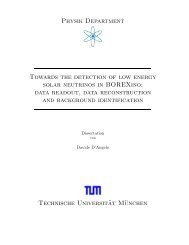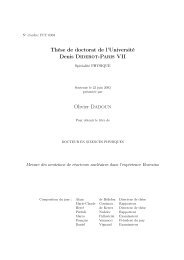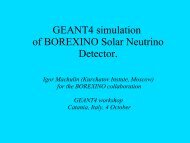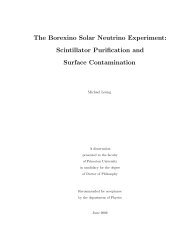Development of a Liquid Scintillator and of Data ... - Borexino - Infn
Development of a Liquid Scintillator and of Data ... - Borexino - Infn
Development of a Liquid Scintillator and of Data ... - Borexino - Infn
You also want an ePaper? Increase the reach of your titles
YUMPU automatically turns print PDFs into web optimized ePapers that Google loves.
Abstract<br />
The first chapter contains a short overview <strong>of</strong> the theory <strong>of</strong> solar neutrinos, their production<br />
inside the sun <strong>and</strong> their detection with present <strong>and</strong> future experiments. The implications <strong>of</strong> the<br />
discrepancy between the predicted <strong>and</strong> the measured count rates that all experiments to date<br />
have seen is discussed, followed by a presentation <strong>of</strong> the different possible solutions to the<br />
solar neutrino problem. The most likely solution, neutrino oscillations, will be discussed in<br />
detail.<br />
The second chapter introduces the physics goals <strong>of</strong> the BOREXINO experiment. The design<br />
<strong>of</strong> the detector <strong>and</strong> its ancillary systems are described. The different types <strong>of</strong> background are<br />
discussed <strong>and</strong> the importance <strong>of</strong> their effective suppression is underlined. In chapter 3 the<br />
design <strong>and</strong> results from the first data taking period <strong>of</strong> the Counting Test Facility (CTF) are<br />
presented, <strong>and</strong> the main design improvements <strong>of</strong> the upgraded CTF2 are shortly discussed.<br />
In chapter 4 a newly developed reconstruction method for scintillation events for both BORE-<br />
XINO <strong>and</strong> the CTF is presented. This method is based on a comparison <strong>of</strong> each real event with<br />
simulated events from known positions, <strong>and</strong> includes a model that describes the generation<br />
<strong>and</strong> propagation <strong>of</strong> the scintillation photons in the detector. Promising results are obtained<br />
with Monte Carlo simulations <strong>and</strong> confirmed by the analysis <strong>of</strong> real data from the CTF.<br />
Chapter 5 discusses the scintillation processes which allow particle identification, <strong>and</strong> the<br />
application <strong>of</strong> neural networks to this problem. Results obtained with Monte Carlo simulations<br />
<strong>and</strong> CTF data show the capabilities <strong>of</strong> this method.<br />
Chapter 6 is devoted to the development <strong>of</strong> an alternative liquid scintillator for the BORE-<br />
XINO experiment, namely PXE. This scintillator <strong>of</strong>fers the advantage <strong>of</strong> a higher density (<strong>and</strong><br />
therefore higher target mass) compared to the solution chosen for BOREXINO (pseudocumene<br />
based scintillator). The results <strong>of</strong> several tests <strong>and</strong> measurements in laboratory <strong>and</strong> in the CTF<br />
are presented. The optical properties (light yield, fluorescence time, absorption <strong>and</strong> reemission),<br />
which are essential for position reconstruction <strong>and</strong> «¬-discrimination, are comparable<br />
to those <strong>of</strong> pseudocumene. The radiopurity level obtained with a newly adopted purification<br />
method using a silica gel column was for U <strong>and</strong> Th below the sensitivity limit <strong>of</strong> the neutron<br />
activation analysis. Due to background problems, however, it was not possible to confirm<br />
these results by the measurements in the CTF.<br />
The last chapter describes the calibration measurements in the CTF2 that I performed. With<br />
these measurements the position- <strong>and</strong> energy-dependent detector response could be tested.<br />
The spatial <strong>and</strong> energy resolution were determined as a function <strong>of</strong> position <strong>and</strong> energy, <strong>and</strong><br />
systematic effects due to the position reconstruction could be excluded.<br />
ii



